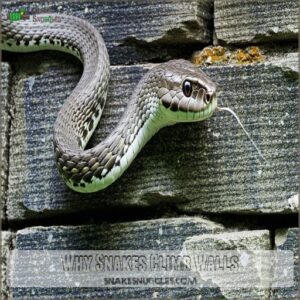This site is supported by our readers. We may earn a commission, at no cost to you, if you purchase through links.

Their ability depends on the wall’s texture and their own species.
Snakes use their flexible bodies, strong muscles, and specialized scales to grip rough surfaces like bricks or stones.
However, smooth materials like metal, glass, or plastic are a challenge.
Agile climbers like corn snakes and garter snakes can scale surprising heights, while bulkier snakes like rattlesnakes prefer slithering across level ground.
To keep snakes out, install smooth fencing and seal any gaps.
Curious to learn more about these slithery wall-climbers? Keep reading to discover the surprising truth about snakes and their climbing prowess.
Table Of Contents
- Key Takeaways
- Snakes’ Ability to Climb Walls
- Snakes That Can Climb Walls
- Surfaces Snakes Can Climb
- Surfaces Snakes Cannot Climb
- Why Snakes Climb Walls
- Snakes Climbing Stairs
- Snakes in Your Walls
- Preventing Snakes From Climbing Walls
- Dealing With Snake Encounters
- Snake Climbing Mechanisms
- Frequently Asked Questions (FAQs)
- Conclusion
Key Takeaways
- You may be surprised to learn that many snakes can climb walls, thanks to their flexible bodies, strong muscles, and specialized scales that provide grip on rough surfaces like bricks and concrete.
- While smooth surfaces like glass and metal pose a challenge, snakes can still find ways to climb them if there are even tiny imperfections they can grip onto.
- Snakes have a variety of reasons for scaling walls, from seeking food and shelter to escaping predators, and they use their advanced climbing skills to navigate your home’s exterior.
- To keep snakes off your walls, install smooth fencing, seal any cracks, and maintain a well-trimmed yard to remove potential hiding spots — your home can stay snake-free with the right prevention methods.
Snakes’ Ability to Climb Walls
You may be surprised to learn that snakes are quite talented climbers.
Their flexible bodies, strong muscles, and specialized scales make them expert wall-scalers, able to reach heights you’d never expect from a slithering creature.
Reasons Why Snakes Climb Walls
Snakes climb walls for a variety of practical reasons.
Whether seeking warmth, hunting prey, evading predators, or exploring their surroundings, these natural-born climbers have mastered the art of scaling vertical surfaces.
Their unique anatomy and techniques, such as utilizing belly scales that act like tiny grappling hooks, allow them to grip even the roughest of snake climbing surfaces.
Their unique anatomy and techniques allow them to grip even the roughest of walls with ease, making them a surprising and persistent presence in our built environments.
How Snakes Climb Walls Using Scales
With their specialized scales, snakes effortlessly cling to walls.
Their ventral scales act like tiny Velcro strips, gripping textured surfaces.
Each species boasts unique climbing methods – some wrap around objects, others press against the wall.
Their varied scale textures allow them to scale unexpected heights, leaving you in awe of their agile prowess.
Snakes That Can Climb Walls
You might be surprised to learn that some snake species are adept climbers, scaling walls and even trees with impressive agility.
From the nimble Corn Snake to the mighty Rattlesnake, these slithering experts use their unique anatomy and skills to conquer vertical surfaces.
Corn Snakes, Garter Snakes, and Hognose Snakes
You might be surprised to learn that agile snakes like corn snakes, garter snakes, and hognose snakes can actually scale walls with ease!
These adaptable reptiles use their flexible bodies and specialized belly scales to grip and climb a variety of rough surfaces in search of food or shelter.
Keep an eye out for these skillful slitherers!
Rattlesnakes Climbing Walls and Trees
Indeed, rattlesnakes may surprise you with their climbing prowess.
These resilient reptiles leverage their flexible bodies and specialized scales to scale walls and trees with ease.
To avoid close encounters, secure your home’s exterior, trim overhanging branches, and keep an eye out for any slithery signs.
With a bit of vigilance, you can coexist peacefully.
Snakes That Are Not Skilled at Climbing Walls
Not all snakes have the same nimble climbing skills.
Snakes with rounder, bulkier bodies often struggle to grip walls, unlike their thin, angular counterparts.
Consider installing a snake barrier around yard perimeters to deter these unwanted visitors.
These ground-dwelling species, like rattlesnakes and copperheads, prefer slithering across level surfaces rather than scaling vertical walls.
Install smooth fencing to give them the slip.
Surfaces Snakes Can Climb
You might be surprised to learn that snakes can actually climb a variety of surfaces, including rough walls made of brick, concrete, or stone.
These slithery creatures use their specialized scales and flexibility to grip and navigate vertical surfaces with ease.
Brick Walls and Concrete Walls
If you have brick or concrete walls around your home, chances are good that curious snakes may attempt to scale them.
These reptiles use their specialized scales to grip onto the rough textures and small cracks, often leaving homeowners puzzled.
To stay one step ahead, seal any cracks, maintain your brickwork, and keep an eye out for any climbing patterns.
Rough Surfaces Like Wood and Stone
Snakes find a true friend in rough materials like wood and stone.
Their overlapping scales grip these textured surfaces with ease, allowing them to ascend with agility.
So, when facing a stone or wooden wall, remember – it’s the snake’s climbing canvas.
Consult experts if you need to restrict these slithery climbers from accessing your property.
Using Nooks and Crannies to Grip
On a brick or stone wall, a snake’s belly scales become tiny grappling hooks, sinking into every nook and cranny to gain a sturdy foothold, much like how some species, like Timber Rattlesnakes, use rattlesnake climbing methods.
Visualize those scales digging in as the snake navigates the rough surface, in contrast to its struggle on smooth, vertical expanses.
Your home can remain blissfully snake-free with the right surface textures.
Surfaces Snakes Cannot Climb
You may be surprised to learn that not all surfaces are easy for snakes to climb.
Smooth materials like glass, metal, and vinyl present a challenge, as snakes struggle to get a firm grip on such slick surfaces.
Smooth Surfaces Like Glass and Metal
The smooth, slippery nature of glass and metal surfaces poses a significant challenge for snakes.
With no traction or friction from specialized scales, these surfaces effectively act as barriers, keeping slithering trespassers at bay.
However, it’s worth noting that snakes can climb glass surfaces if they’ve microscopic imperfections to dig their belly scales into, as explained in techniques for snake climbing glass.
Snakes simply can’t get a grip on the slick, frictionless material, making vertical scaling an impossible feat.
Vinyl Siding and Fencing
Vinyl siding acts as a sleek barrier against sneaky snakes.
Its glossy surface is a natural deterrent, leaving your home snake-proof.
Install vinyl fencing, seal any gaps, and trim nearby bushes for extra protection.
DIY solutions like sprays or repellents offer an added layer of security against these slithery climbers.
Plaster Walls and Wallpapered Walls
Plaster walls and wallpapered surfaces act like slippery slopes for snakes, denying them any traction to climb.
The smooth texture and minimal friction make these surfaces inhospitable for sneaky serpents.
To snake-proof your home, make sure walls have a slick, uniform finish that leaves no opening for these agile climbers.
Why Snakes Climb Walls
Why do snakes climb walls?
You might be surprised to learn that snakes have specialized adaptations that allow them to scale vertical surfaces.
From seeking warmth and hunting prey to escaping predators, snakes have a variety of reasons for taking to the walls.
Finding Food and Shelter
Snakes don’t climb walls just for fun; they’re on a mission.
They’re after a tasty meal, like a rodent, or a comfy nook for resting.
These sneaky climbers are drawn to walls that offer potential food sources and cozy shelter.
Keeping your walls slick and unfriendly can help keep these slithery guests away.
Escaping Predators and Harsh Weather
If a hawk’s circling overhead, climbing a wall might just save a snake’s life. These clever reptiles use their tough scales and flexibility to scale vertical surfaces, seeking refuge from predators and harsh weather. Mastering their environment is key to their survival – it’s their natural camouflage against danger. For those fascinated by this ability, you can even buy snake wall climb gear online at reptile climbing products.
- Slip into hard-to-reach nooks for protection
- Blend into brick or stone walls seamlessly
- Escape frigid temps by finding warm pockets
- Evade hungry hawks, foxes, and other threats
Sensing Prey and Heat Through Walls
In their quest for food, snakes reveal a talent many don’t see coming: detecting prey through walls.
With infrared sensing akin to thermal imaging, they sense heat signatures and prey movement effortlessly.
Picture them tuning in to vibrations like a radar gun, sensing even the slightest quiver.
It’s the ultimate survival skill, turning sneaky into an art form.
Snakes Climbing Stairs
Did you know snakes can also climb stairs?
Their flexible bodies and specialized scales allow them to navigate steps with surprising ease.
Whether you’re dealing with snakes in your home or just curious about their climbing abilities, understanding how they tackle stairs can provide some fascinating insights.
How Snakes Use Flexibility to Climb Stairs
Curious how these legless wonders manage stairs?
It’s their unique blend of body size and grip strength that lets snakes tackle this architectural challenge.
They leverage each step’s design, making good use of any ridges or textures.
To a snake, your stairway is a cleverly crafted climbing frame they can navigate with ease.
Minimum Height Requirements for Snake Stair Climbing
You’ve probably worried about snakes slithering up your stairs.
Well, a snake’s climbing ability depends on the step height.
For successful stair climbing, make sure each step isn’t more than half the snake’s length.
Taller steps can trip up even the most agile snakes.
Designing stairs with this height limit in mind adds an extra layer of safety.
Snakes in Your Walls
Are your walls suddenly slithering with snakes?
Don’t panic – it’s not as uncommon as you might think.
While snakes aren’t the most welcome houseguests, understanding their climbing abilities and the types that may end up in your walls can help you prevent and address any unwanted snake encounters.
Signs of Snakes Living in Your Walls
Suspect your home has become a snake’s secret hideaway? Keep an eye out for telltale signs like scattered droppings, shed skin, or strange hissing and wall vibrations.
snake holes in your yard could be a sign of a snake’s presence that can eventually lead to them finding their way into your walls.
These could mean a slithery visitor has made themselves comfortable within your walls. Stay vigilant and contact a professional if you spot any suspicious activity.
Types of Snakes That Live in Walls
Snakes sneaking into your walls? Don’t panic – we’ve got the scoop on the likely culprits.
Consider investing in a wall snake trap to catch unwanted visitors.
Common wall-dwellers include docile corn snakes, speedy garter snakes, and even intimidating rattlesnakes.
Nail down their size and behaviors to strategize safe removal.
The key is accurate identification – consult a pro if you’re unsure.
Snakes sneaking into your walls? Don’t panic – we’ve got the scoop on the likely culprits.
Consider investing in a wall snake trap to catch unwanted visitors.
Common wall-dwellers include docile corn snakes, speedy garter snakes, and even intimidating rattlesnakes.
Nail down their size and behaviors to strategize safe removal.
The key is accurate identification – consult a pro if you’re unsure.
Prevention and Removal Methods
Got a sneaky snake slithering up your walls? No need to panic – we’ve got your back!
Start by installing some snake-proof fencing to block their path. You can also try DIY deterrents like natural repellents.
But if things get hairy, it’s best to call in the pros for safe removal.
And remember – keep that landscaping tidy to reduce hiding spots.
Your home, snake-free – it’s totally doable!
Preventing Snakes From Climbing Walls
Worried about slithery snakes scaling your walls? No need to panic! Seal up cracks, trim back vegetation, and install smooth fencing to keep those climbing critters at bay.
Using Smooth Walls and Fencing
Want to keep pesky snakes off your walls?
Smooth surfaces like vinyl fences, metal siding, and glass panels are a clever deterrent.
These sleek materials make it nearly impossible for snakes to get a secure grip and climb up.
Upgrade your defenses with these clever solutions and enjoy a snake-free home.
Trimming Vegetation and Removing Debris
Keep your yard tidy and trim to deter snakes from setting up shop.
Regularly prune back overgrown vegetation that provides hiding spots, and remove any piles of debris or clutter that could attract these slithery visitors.
A well-maintained, open yard makes it harder for snakes to find the shelter and warmth they crave.
Sealing Gaps and Removing Downspouts
Tiny cracks and crevices in your home’s foundation are like open invitations for sneaky snakes.
Seal those gaps with the right sealant to close off potential entry points.
Don’t forget about your downspouts either – snakes love using them as climbing ladders.
Removing or modifying downspouts can be a game-changer in keeping slithery pests at bay.
Dealing With Snake Encounters
Encountering a climbing snake can be startling, but staying calm and keeping your distance is essential.
Contact a professional wildlife expert to safely remove the snake and prevent any potential harm.
Staying Away From Climbing Snakes
Spotted a climbing snake? Don’t panic – stay calm and keep your distance.
Slowly back away, keep an eye on the snake, and alert others nearby.
Understanding why snakes are in your yard, such as attracted to food sources, can help you take preventative measures.
To prevent snake encounters, focus on snake-proof landscaping, remove hiding spots, and consider professional snake removal services if needed.
Knowing how to stay safe around snakes is important.
Contacting Professionals for Snake Removal
Spotting a snake slithering up your walls? It’s time to call in the pros!
Professional snake removal guarantees safety and expertise when dealing with both venomous and nonvenomous snakes.
They’ve got the know-how and local resources to handle sneaky serpents without breaking a sweat.
Comparing costs and checking licensing requirements can save you time and stress, keeping those climbing critters in check!
Using Snake Repellents and Deterrents
When dealing with sneaky snake visitors, DIY deterrents and snake repellents can be handy allies.
From natural options to commercial products, the key is choosing the right solution for your needs.
Weigh effectiveness, safety, and ease of use to find the perfect fit.
With a little research, you can keep slithery climbers at bay.
Snake Climbing Mechanisms
You’ll be amazed by how snakes use their unique anatomy to defy gravity and climb walls.
From their specialized belly scales to their flexibility and muscle coordination, snakes have a surprising array of climbing mechanisms that allow them to scale even the slickest surfaces.
Concertina Locomotion and Belly Scales
How do snakes manage to scale walls with such effortless grace?
The secret lies in their impressive concertina locomotion and specialized belly scales.
These slithering experts use powerful muscles to push and pull against surfaces, while their grippy ventral scales cling to even the roughest textures.
Flexibility and frictional force work in tandem, allowing snakes to defy gravity and ascend vertical obstacles.
Stretching and Pulling The Body Upward
Snakes leverage their incredible flexibility and muscle power to tackle vertical surfaces.
By stretching and pulling their lithe bodies upward, they can navigate even the slickest walls.
Watch as a snake serpentines up, its belly scales gripping tight while it twists and turns, finding the perfect footholds.
It’s all about balance, energy, and that signature snake agility.
Quite remarkable, isn’t it?
Frequently Asked Questions (FAQs)
Can a snake climb a brick wall?
You bet your bottom dollar!
Snakes, with their slender bodies and strong muscular coordination, can scale brick walls with relative ease.
The textured surface of bricks provides ample grip for these agile reptiles.
Can snakes climb cement walls?
While cement walls may pose a challenge, some snakes can certainly make the climb, thanks to their strong muscles, flexible bodies, and specialized scales that provide extra grip.
But the challenge depends on the snake’s species and the wall’s texture.
Can snakes climb fences?
Well, let’s climb aboard this snake-climbing adventure!
While some species can scale fences with ease, others might struggle to get a grip.
It all depends on the snake’s size, muscle power, and the fence’s material.
How do snakes climb walls?
Snakes climb walls using their flexible bodies, strong muscles, and specialized scales that provide traction.
They can navigate vertical surfaces by employing various movements like lateral undulation and concertina motion to grip and propel themselves upwards.
Can rattlesnakes climb walls?
Rattlesnakes, being terrestrial snakes, aren’t the best climbers compared to arboreal species.
Their large, bulky bodies and rougher scales make it challenging for them to scale smooth, vertical surfaces like walls effectively.
Conclusion
Forget climbing walls – snakes are Olympic-level contortionists, scaling impossibly smooth surfaces and slithering through miniscule cracks.
While these slippery serpents can’t pull off a Spider-Man worthy performance on every wall, their impressive grip and flexibility make them a force to be reckoned with.
So next time you spot a snake, don’t be surprised if it’s casually strolling up your brickwork – can snakes climb walls? You bet they can.


















